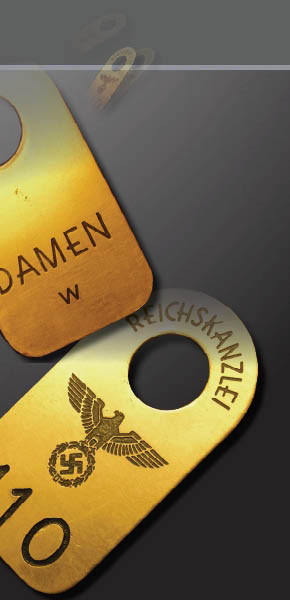
Gauleiter Hartmann Lauterbacher | Non-Portable Award | Silver & Black Marble.
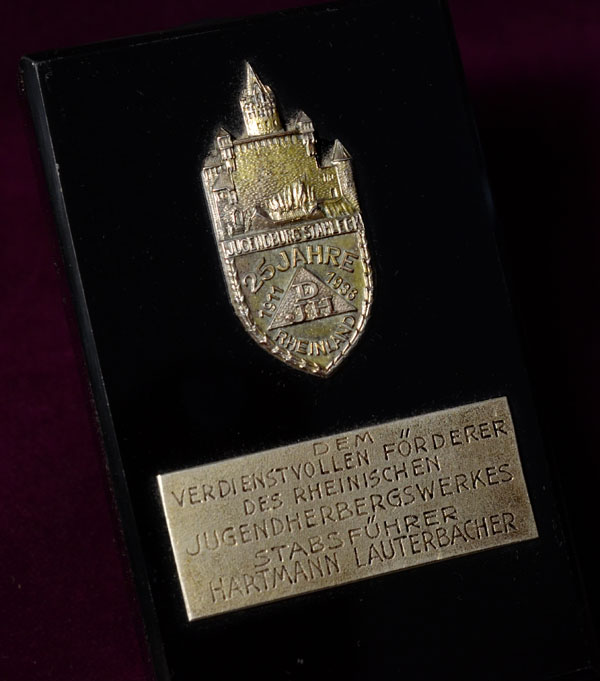

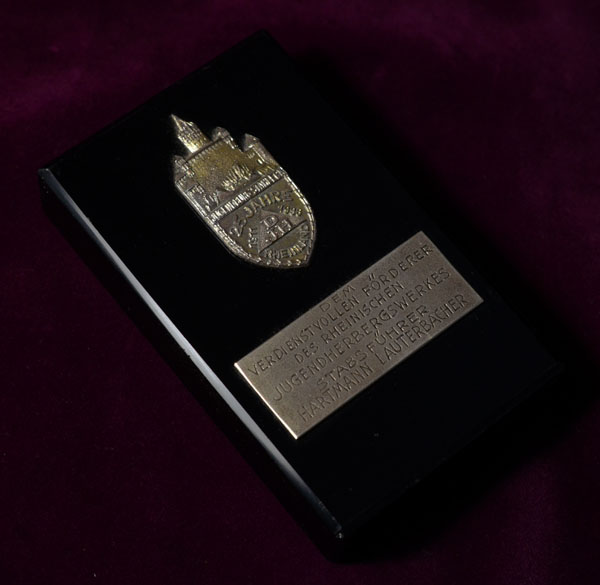
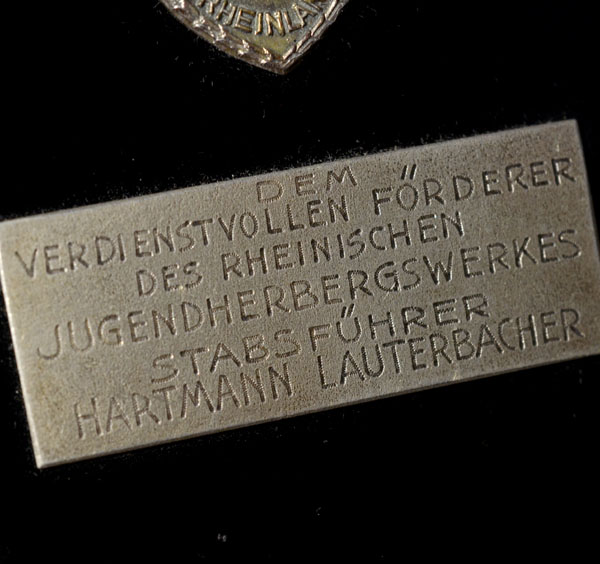
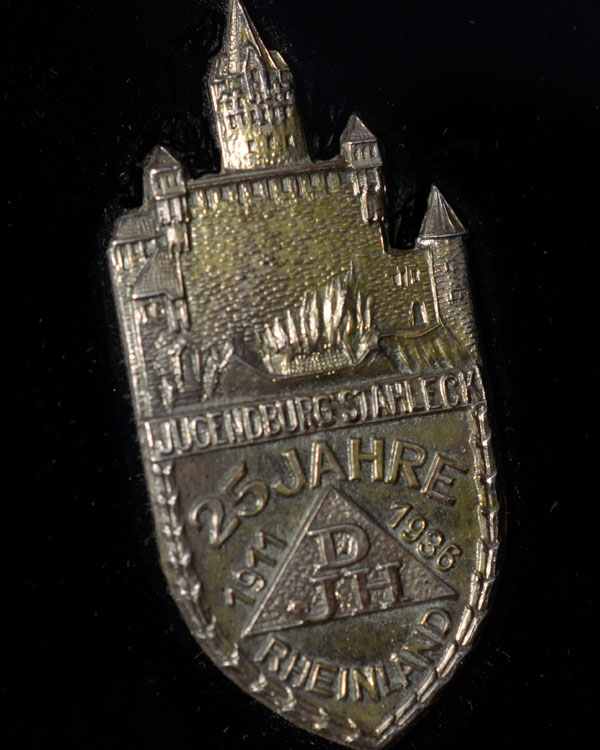
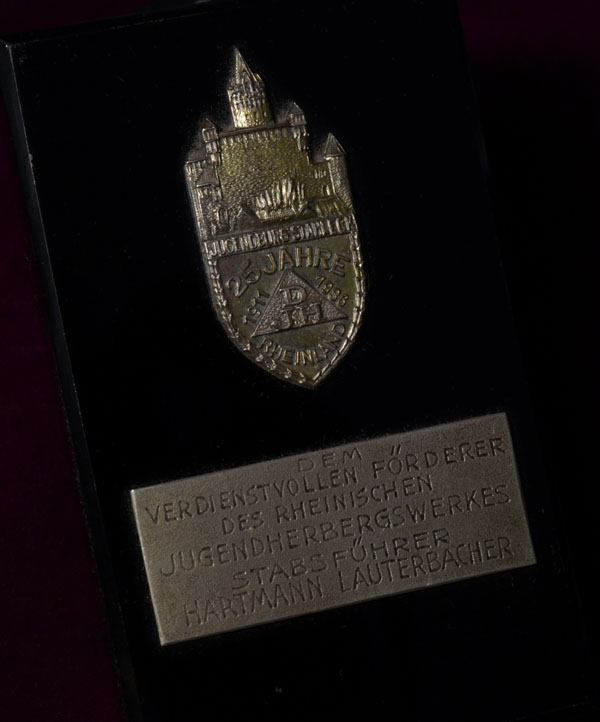
Gauleiter Hartmann Lauterbacher non-portable award for sale. The black polished marble plaque with attached silver plaquette with castle motif. The plaquette with designation 1911 - 1936 - 25 years of the German Youth Organisation (this officially became the Hitler Youth in 1933). A further silver plaquette bears the dedication, "DEM VERDIENSTE FORDERER DES RHEINISCHEN JUGENDHERBERGSWERKE STABSFUHRER HARTMANN LAUTERBACHER."
Size: 10cm x 6 cm x 2cm.
Condition report: The award in close to near mint condition. The silver plaquettes showing light age patination.
Notes: This non-portable award was given to the HJ leadership of the Rheinland area in 1936. Numbers given out by Lauterbacher aren't known, but are believed to be small (less than 20).
Background to Hartmann Lauterbacher: During 1923, the then 14-year-old Hartmann Lauterbacher became a member of the Austria-based NSDAP's youth organization. It is even said that Lauterbacher founded the first ever NSDAP youth local in Austria. In 1925, when he was 16 years old, Lauterbacher was the leader of the Deutsche Jugend ("German Youth"), which he transferred to the Hitler Youth in 1927. He moved to Braunschweig in 1927, and joined the NSDAP.
Between 1932 and 1933, Lauterbacher was appointed leader of the Westphalia-Lower Rhine area, and between 1933 and 1934 he was appointed high area leader of the Hitler Youth West.
On 22 May 1934, Baldur von Schirach appointed Lauterbacher his deputy and Stabsführer. In 1936, Lauterbacher functioned as a member of the Reichstag, and by April 1937 as a ministerial adviser.
While von Schirach was away performing a short stint in the military, Lauterbacher took over the Hitler Youth's leadership. When Lauterbacher found himself having to spend a few weeks undertaking military service with the SS, he suffered an accident and was wounded badly enough to make deployment anywhere other than on the homefront quite impossible.
However, since a Hitler Youth leader could not show any sign of physical flaw or marring, Lauterbacher had to hand his position over to Artur Axmann, who now became Baldur von Schirach's deputy. Helmut Möckel became Stabsführer.
In August 1940, Lauterbacher was appointed acting Gauleiter of South Hanover-Braunschweig, and on 8 December 1940, as Science and Education Minister Bernhard Rust's successor, he was appointed full-fledged Gauleiter. At the same time he received an appointment as Honorary Leader of the Academy for Youth Leadership in Braunschweig
In January 1941, Lauterbacher was appointed to the Prussian State Council, and took over as High President (Oberpräsident) of the Province of Hanover on 1 April 1941 as SA Chief of Staff Viktor Lutze's successor. At about the same time came his promotion to SS Gruppenführer. Lauterbacher's last promotion came in November 1942, when he was appointed Reich Defence Commissar.
On 10th April 1945, shortly before the Allied forces marched into Germany (and only 20 days before Adolf Hitler killed himself), Lauterbacher took his family to safety in the Harz - but not without having announced over wired radio the requisite exhortations to hold out against the onslaught.
Two days earlier, on 8th April, he had loaded his car up with cigarettes so that he could flee south from the Harz posing as a cigarette sales agent. Nonetheless, only a day after leaving his family in the Harz, on 11th April, after making it as far as Carinthia, Hartmann Lauterbacher was seized and taken prisoner by the British.
Early in July 1946, the High British Military Court in Hanover acquitted Lauterbacher of the charge of having ordered early in April 1945 the murder of German and Allied detainees at the prison in Hamelin.
In August 1947, new proceedings against Lauterbacher began at the Dachau International Military Tribunal. At issue this time was an order allegedly given by Lauterbacher in September 1944 for the shooting of twelve American airman who had been shot down over Goslar. In October 1947, this trial, too, ended in acquittal.
Lauterbacher, who since the end of the war had been interned in the Sandbostel camp near Bremervörde, managed on 25th February 1948 to flee detention owing to circumstances that are still unclear.
He went underground, until he was arrested in Rome in April 1950. Here he was dealing with people smugglers who took people from former fascist states with warrants or charges outstanding against them to South America or the Middle East.
Sent to the La Frachette camp near Rome by the Italians, who had declared him an "undesirable foreigner", Lauterbacher still managed to flee a few months later, in December 1950, to Argentina, following the same route Adolf Eichmann took the same year. In Buenos Aires he helped develop ratlines for other Nazis seeking to flee from Europe.
From there he went to Egypt with the assistance of the CIA and West German intelligence to train anti-Israel guerrillas.
He was reported by the police in Munich on 4th September 1956. As more intensive investigations got underway, Lauterbacher once more went underground, this time, though, without leaving any trail.
In the early 1980s it came to light that between 1977 and 1979, Lauterbacher had been working as an adviser in the Omani Ministry of Youth. The last few years of his life he spent very reclusively in Germany. Only his death certificate establishes that he died in Seebruck.
Hartmann Lauterbacher, Baldur von Schirach's deputy, was said to be the organizational talent and the active element of the Reich Youth Leadership. As Gauleiter and High President in Hanover, he bore a great deal of the responsibility for stripping Jews of their rights and deporting them.
German justice, which had already begun proceedings through the Hanover prosecutor's office in 1947, later followed by investigative proceedings in Munich and Hanover, contented itself, however, to discontinue the investigation owing to lapse of time.
The suspicion keeps arising that Hartmann Lauterbacher was active in the Allied secret service, and the Gehlen Organization.
Provenance: Acquired by Hitler Youth collector, Harry Hinds, in the late 1970s. Sold in the late 1980s, and in one collection since that time.
Price:
£ 675.00
Please click here to send an email about this item, or phone 00 44 (0) 1694 781354 to arrange or discuss purchase, quoting stock number: g008369
Click here to return to category.
